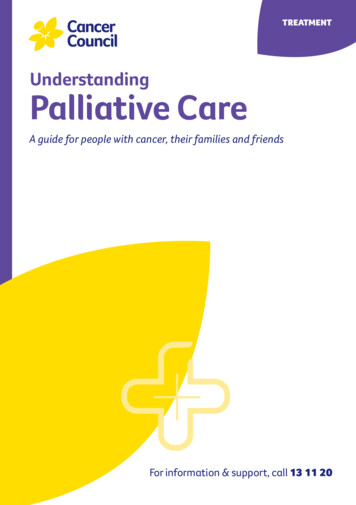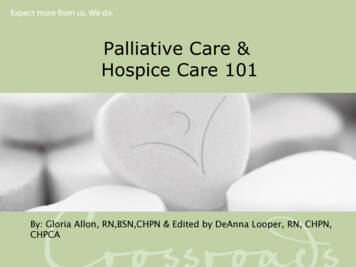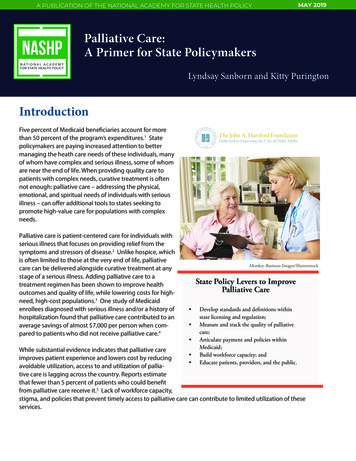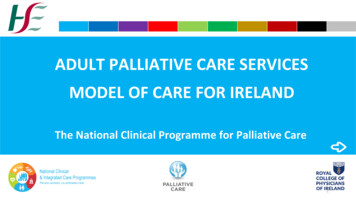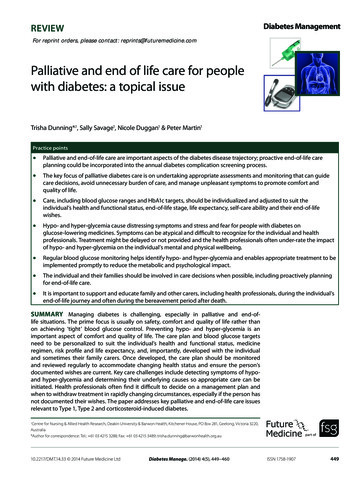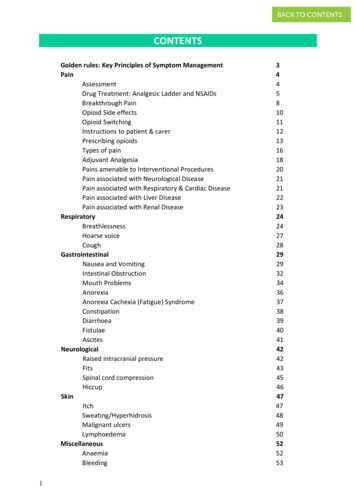
Transcription
BACK TO CONTENTSCONTENTSGolden rules: Key Principles of Symptom ManagementPainAssessmentDrug Treatment: Analgesic Ladder and NSAIDsBreakthrough PainOpioid Side effectsOpioid SwitchingInstructions to patient & carerPrescribing opioidsTypes of painAdjuvant AnalgesiaPains amenable to Interventional ProceduresPain associated with Neurological DiseasePain associated with Respiratory & Cardiac DiseasePain associated with Liver DiseasePain associated with Renal DiseaseRespiratoryBreathlessnessHoarse voiceCoughGastrointestinalNausea and VomitingIntestinal ObstructionMouth ProblemsAnorexiaAnorexia Cachexia (Fatigue) ogicalRaised intracranial pressureFitsSpinal cord ignant 142424345464747484950525253
BACK TO CONTENTSVenous ThromboembolismHypercalcaemiaSteroid UseDiabetes ManagementEnd stage Long-Term Conditions: Heart, Kidney, COPDEnd of LifeFuture and Advance Care PlanningDNACPR DecisionsLast Few Days of LifeAnticipatory PrescribingSyringe DriverSetting upDrugs ssConfusionRestlessnessBreaking Bad NewsDenialCollusionPsycho-social and SpiritualSpiritual CareCultureBereavementIndex and AppendicesUseful 69727273757576777879818284858687899092949495962
BACK TO CONTENTSGOLDEN RULESThere are some key principles or ‘Golden Rules’ which underpin symptom management. Theseinclude:Assess and diagnose the cause of symptoms, before planning symptom managementTreat potentially reversible causes, where appropriateAlways consider non-drug approaches as they can be as important as the use of drugsManagement plan is influenced by prognosis and patient choice and depends on thetherapeutic goalPlan regular review and reassessment for all symptomsThe WHO Analgesic Ladder remains the basis for prescribing for all types of painSet therapeutic goals for drug prescribed e.g. use opioids as analgesics, not for sedationAll drugs need a review date; the goal is to use the minimum effective doseAdopt a Team approachAsk for Specialist advice in difficult situations3
BACK TO CONTENTSPAINAll sections of this book focus on management of patients with advanced and progressivedisease, including both malignant and non-malignant conditions. The advice is not meant toguide the management of chronic pain, which, though also multi-dimensional, requires longterm management plans focussing more on psychological interventions and less on opioid use.Pain is a complex symptom which is influenced by physical, psychological, social and spiritualfactors.Multiple pains are common. In cancer patients with pain: one third will have one pain, onethird will have two pains and one third will have three or more pains. Multiple pains arecommon in non-malignant and co-morbid conditions. They may also occur as a result of age,debility and medical treatment.Pain AssessmentAssessment and management of pain should follow relevant Golden Rules and the stepsoutlined for assessment of any symptom (ref p3). It is important to assess each pain separatelyto make a diagnosis and treat accordingly.Pain assessment toolsTools such as a numerical rating scale or visual analogue scale may help the patient to describethe severity of the pain and the response to treatment. Tools are also available for assessmentof pain in people with learning difficulties, dementia and other communication issues.Pain managementOnce a pain has been assessed and diagnosed, aim to treat any reversible cause. Alongsidethis, or if the cause is irreversible, the WHO Analgesic Ladder remains the basis for prescribingin all types of persistent pain.NON-DRUG TREATMENTSConsider the use of: Relaxation techniques Psychological Assessment and Support Distraction Heat pad/ ice pack TENS Acupuncture Creative Therapies4
BACK TO CONTENTSDRUG TREATMENTSWHO Analgesic Ladder analgesics should be given regularly it is essential to use an analgesic appropriate to the severity of the pain patients with palliative care needs, whose pains do not respond to weak opioids,need a trial of management with strong opioids all patients taking opioids should also be prescribed laxatives the oral route is preferred for all steps of the ladderCo-analgesia (non-opioid medication) should be prioritised in non-malignant and longerprognosis conditions.STEP 1Consider a trial of Paracetamol and stop if not clearly effective.ParacetamolCan be given orally (tablet or liquid), via PEG, rectally or IV.Usual dose 0.5 -1g qds, maximum 4g in 24 hours.Risk of hepatotoxicity is increased in those who are malnourished or have abnormal liverfunction.Reduce dose in the frail elderly and those who weigh less than 50kg to a maximum of 2g in 24hours.4hr half-life and qds dosing of 1g may mean that a patient only has pain relief available tocover 16hrs a day.5
BACK TO CONTENTSNON-STEROIDAL DRUGS (NSAIDs)NSAIDs are particularly useful for pain caused by inflammation or exacerbated bymovement, however the risk/ benefit balance must always be considered.Serious Gastrointestinal Events with NSAIDsRisk is I in 500 with 2 months of treatment, likely increased in debilitated patients at endof life and decreased by gastro-protection. Depends not only on the NSAID used but onother factors such as the dose and duration, concurrent medications and age 65. Of theNSAIDs commonly used in palliative care, Ketorolac is high risk, Diclofenac, Naproxen andhigh dose Ibuprofen ( 1200mg/24 hours) are moderate risk and Ibuprofen is relativelylower risk.Serious Thrombotic Events with NSAIDsThe absolute risk for serious thrombotic events (stroke, myocardial infarction) with NSAIDsremains small, however Ibuprofen and Naproxen have been found to be the least likely toincrease risk.Other Serious Side EffectsBeware of NSAIDs exacerbating renal and cardiac failure and consider the risk ofbronchospasm.Prescription of NSAIDsAlways consider a PPI alongside NSAIDs.Take into account an individual’s risk factors and use the lowest dose possible to achievepain control.First line: Ibuprofen 400mg tds POSecond line: Naproxen 500mg bd POThird line: Diclofenac SR 75mg bd PO/ 100mg od pr/im or 150mg/ 24hrs csciKetoprofen, Diclofenac and Ketorolac may be given as a csci* recommend specialist adviceSTEP 2Codeine Codeine Phosphate 30-60mg 4-hourly PO Codeine in combination with Paracetamol e.g. Cocodamol 30/500, 2 tablets qds PO Constipation is a common side effect Around 10-15% of the population do not respond to a Step 2 analgesic but will respondnormally to step 3. Those with a sensitivity/allergy to morphine may also react to codeineTramadol (Controlled drug) Has an opioid effect but also acts as a serotonin and noradrenaline reuptake inhibitor Nausea is a common side effect Tramadol Hydrochloride 50-100mg qds (maximum 400mg/24 hours), also available as amodified release preparation Risk of serotonin toxicity when given with other serotonergic drugs (clonus, sweating,tremor, agitation, and in extreme cases, death)6
BACK TO CONTENTSSTEP 3 – STRONG OPIOIDSIf patients do not achieve useful relief of pain when titrated to doses between 120-180 mgmorphine equivalent per 24 hours, referral to a specialist in palliative or pain medicine isstrongly recommended and additional adjuvants are likely to be needed.MorphineRemains the first-line strong opioid (except in renal impairment), oral is the preferred route.Not all pains are opioid responsive, and some respond better to one opioid than another dueto individual differences in drug pharmacokinetics.Elderly and cachexic patients and those with renal impairment may need lower doses, reducedfrequency or alternative opioids: see table on p23We recommend that all opioids are prescribed by brand name to avoid confusion.Commencing oral opioidsCalculate the morphine equivalent of any Step 2 drugs to guide starting dose e.g.The codeine in Cocodamol 30/500 2 qds (total 240mg) Morphine 24mg/24hrs.Start with either regular Immediate Release IR morphine sulphate (e.g. Oramorph) 2.5mg(15mg/day) to 5mg (30mg/day) 4 hrlyOr Modified release MR morphine sulphate 10mg (20mg/day) to 15mg (30mg/day) BDIf Opioid Naive or infrequent use of Step 2.Regular Morphine IR 2.5-5mg 4 hourly,with the same dose as rescue (PRN)If frequent use of Step 2.Calculate the equivalent Morphine M/R bddose, with Morphine IR PRN for rescue (1/6of the daily M/R dose)Increasing doses should only occur if it is clearthat the pain is responding to morphine.Titrate dose to one which controls painwithout causing toxicity. Aim for a dosethat provides clinical benefit after 40minutes which lasts for 3-4 hoursChange to modified release Morphinee.g. If on 15mg Oramorph 4 hourly (6/day) 45mg bd MR Morphinewith 15mg Oramorph PRN forbreakthrough pain (ref p8)Record PRN usage. Increase dose ofMorphine M/R by 30-50% if 3 or more PRNdoses are required per day over 2-3 daysContinue to titrate if requiredIf pain is controlled, but there is evidence oftoxicity, reduce the dose.If pain is uncontrolled, with evidence of toxicity, seek specialist advice and consider opioidswitch or adjuvants (ref p10)7
BACK TO CONTENTSBREAKTHROUGH PAINBreakthrough pain is a transient exacerbation of pain occurring despite adequate backgroundanalgesia.Encouraging patients/carers to maintain a record of use of breakthrough doses will be helpfulto guide when an increase in background pain relief may be needed.Poorly controlled background pain and pain occurring shortly before the next dose of regularopioid (end-of-dose failure) are managed by titrating up the regular opioid.The dose of breakthrough medication should be one sixth (1/6) of the daily background opioiddose:e.g. A patient on Morphine M/R 120mg bd ( 240 mg morphine per day) should haveMorphine I/R (Oramorph or Sevredol) 40mg prn (240 x 1/6)ProblemFeaturesSuggested managementIncident painPain associated withan incident e.g.movement,swallowing,defaecating, coughing,dressing changes,weight-bearingManage precipitating factorsRescue medication of IR opioid at least 30 minutesprior to incidentConsider NSAIDs/ AdjuvantsConsider SL / buccal / nasal Fentanyl preparationsSpontaneousbreakthroughpainPain occurs withoutRescue medication of IR opioidan obvious trigger,Consider adjuvantse.g. colic, neuropathic Consider titrating background analgesiapainSome patients appear to gain psychological as well as pain benefit from use of prn short actingopioids, possibly by allowing the patient to have control over their pain management.Increasing their background pain relief may lead to drowsiness or opioid toxicity without anyreduction in the frequency of prn use. Accepting prn use 3 times per day and keepingbackground pain relief relatively low may work best in these patients.Sublingual / Buccal / Nasal Fentanyls*: Use in Incident PainThese are expensive compared with Oramorph and are best left for specialist use.They are licensed for use in incident pain; as they are slightly faster acting compared withtraditional IR opioids – i.e. prescribe at least 10 minutes prior to an incident likely to cause pain.The dose is not related to background opioid dose and drugs are not interchangeable. Start atlowest dose and titrate up to effective level. They must not be used in opioid naive patients.* for specialist use or after specialist advice8
BACK TO CONTENTSTRANSDERMAL OPIOIDSTransdermal (TD) opioids are contraindicated for acute pain and in severe uncontrolled painrequiring rapid dose titration, due to their long half-life. In cachexic patients absorption may beunpredictable, so TD drugs should be used with caution as conversion charts may not apply.Cutting patches is not recommended.Suggested management (for stable pain)NotesCalculate current oral Morphine equivalentdose and use conversion table as a guide towhich TD drug and dose to commence.For opioid naive patients, the loweststrength Buprenophine patchApply patch.TD medications take at least this long toreach effective plasma levels.Continue current opioid regime for 12 hoursbefore stopping.Options for rescue medications: Consider adjuvantsImmediate release morphine or oxycodoneFentanyl, Morphine, OxyNorm orDiamorphine SC if unable to tolerate oralmedicationNSAIDsWait at least 72 hours before titrating dose.Titrate by a maximum of 25-50% of dose.(BuTrans 5mcg/hr) may be appropriate.Some patients experience a degree ofwithdrawal when switching from morphineor oxycodone to Fentanyl, which can bemanaged with small doses of regularOramorph or OxyNorm for the first fewdays.Fentanyl is not as constipating as otheropioids so laxatives may need to bereduced.It can take up to 3 patch changes toreach steady-state plasmaconcentrations of TD drugs.Dose increases will take at least 12hours to take effect.Plasma levels of TD drugs remain raised for at least 24 hours after removal of patch – relevantin switches from TD to alternative routes, and in managing toxicity.For management of patches in last days of life; ref p70.9
BACK TO CONTENTSOPIOID SIDE EFFECTS AND TOXICITY (Grey boxes indicate immediate action is required)Side effectNotesSuggested managementConstipationVirtually inevitableProactive prescribing of softening & stimulantlaxativesMethylnaltrexone rarely neededNauseaUsually settles after a few daysLess likely with slow titrationIf persistent consider toxicityConsider Haloperidol 0.5-1.5mg at night PO orDry mouth,hiccups, sweating,vivid dreamsToxicity –myoclonus, pinpoint pupils,hallucinations,delirium, sedationRespiratorydepression(RR 8bpm &reducedsaturations)Opioid-inducedhyperalgesia* (OIH)Domperidone or Metoclopramide 10mg tds POManage symptomatically ref p34, 46, 48, 77Consider opioid switch if severeMay be precipitated by rapiddose escalation, accumulation(particularly Methadone,Fentanyl patches), renal orhepatic impairment,dehydration or infectionSign of severe toxicityReduce doseSeek specialist adviceMonitor respiratory rateCorrect renal impairment if appropriateConsider opioid switch and adjuvantsConsider admissionStop regular opioid (remember to removepatches) and use prn opioids at half dose untilimprovement in respiratory rate (RR) andconscious levelSeek specialist adviceConsider urgent bloods and give iv or sc fluids ifdehydrated to aid opioid clearanceConsider the cause e.g. change in renal functionUse Naloxone only if severe as will causereversal of analgesia with sudden severe painWhen stable: Restart opioid at half dose orconsider switch to short acting opioid oralfentanil csci, monitor carefullyWidespread and worseningpain, hyperalgesia, allodynia,myoclonus, delirium, sedationand fitsReduce dose by 30- 50%Seek specialist adviceConsider opioid switch, NSAID, adjuvantsOpioid-induced Hyperalgesia*Pain can be paradoxically increased as a result of taking an opioid. It can occur at any dose andwith any opioid. Failure to recognise OIH can result in escalating opioid and sedative effect.It should be considered if: tolerance to opioids develops rapidly dose increases result in worsening pain or have short-lived benefit the pattern of pain changes (distribution beyond the original site)If this condition is suspected, seek specialist advice.10
BACK TO CONTENTSOPIOID SWITCHINGIssue with oral MorphineSuggested switchNotesUnable to achieve goodpain control withoutcausing toxicityOral oxycodoneMany people who do not toleratemorphine will tolerate another opioid(provided pain is opioid-responsive)DysphagiaTD preparation e.g.Only for stable and well-controlledBuprenorphine or Fentanyl pain as titration is difficultBuprenorphine and Fentanyl are lessconstipating than other opioidsPoor oral concordanceUncertain absorptionIntractable constipationNausea or vomitingInability to tolerate oralmedication in the terminalphaseRenal impairment*(eGFR 30)For further details ref p23Continuous subcutaneousinfusion (csci ) via syringedriverConvert to same opioid sc that hasbeen given orallyPrescribe sc prn dosesBuprenorphine or Fentanyl The majority of opioids accumulate inTDrenal impairmentAlfentanil or Fentanyl csci Buprenorphine, Fentanyl andAlfentanil are safer.Rescue medication:There is little evidence for Oxycodonebut it appears safer than morphineLow dose and infrequentoxycodone IR or buccal / sl/ sc fentanylOther options (for specialist initiation only) include: 11Methadone* - difficult titration and can accumulate, but may be useful in complex andneuropathic pain.Oxycodone with naloxone combination drugs* – consider when intractable constipationdespite optimal laxative use.
BACK TO CONTENTSINSTRUCTIONS TO THE PATIENT AND CARER ABOUT OPIOID USE Emphasise the need for regular administrationExplain about rescue (prn) medication for breakthrough painWarn about possible side effects- Explain need for regular and ongoing laxatives- Nausea can be a problem initially – take antiemetic regularly for the first fewdays and prn after thatReassure that when used for pain relief, problems with tolerance and psychologicaldependence are very rareAdvise not to stop abruptly due to potential withdrawal effectsOpioids and drivingStable doses of appropriately titrated opioids do not preclude driving, however patients shouldbe advised: Not to drive for the first week after starting opioids Not to drive for 3 hours after taking a rescue medication Not to drive for 48 hrs after changing long acting opioid dose To drive only if feeling alert and entirely safe to do so To start with a short and familiar drive, with a companion To inform their insurance company, who may advise that the DVLA should be informed Carry proof of medication prescribed e.g. repeat prescriptions It will be an offence to be over new legal limits for many medicines (e.g. opioids,benzodiazepines) whilst driving, as it is with drink driving, from 2015.Opioids and travel abroadDuration of travel and requirementsLess than 3Medical letter stating demographics, place and dates of travel andmonthsfull details of drugs. Import and export requirements for allcountries en route should be fulfilledMore than 3Medical letter and import/export requirements as above, plusmonthsexport license (available from the Home Office website), unlessarrangements can be made in the destination country for aprescription to be completed12
BACK TO CONTENTSPRESCRIBING OPIOIDSThe conversions given are approximate and vary between individuals – the diagrams/ chartsshould be used only as a rough guide.At higher doses consider a reduction in the dose when converting from one strong opioid toanother as there is a risk of toxicity. It is safer to start lower and titrate up as needed.Seek specialist advice for conversions at higher doses.The conversion to and from methadone is variable and should only be attempted in aninpatient specialist unit (risk of accumulation and toxicity).OPIOID CONVERSION DIAGRAMMost data on doses are based on single dose studies so they are not necessarily applicable inchronic use, also individual patients may metabolise different drugs at varying rates. Theadvice is to always calculate doses using morphine as standard and to adjust them to suit thepatient and the situation. Caution should be used in renal and hepatic failure. Some doses havebeen rounded up or down to fit with the preparations available. Avoid patch use in unstablepain.How to use these tables:Look for the name of the drug you wish to prescribe. Then decide which route you wish to use.For parenteral use we recommend the subcutaneous route. If you are giving a long actingopioid (12 hrly dose or patch), you will need to prescribe a prn dose for breakthrough pain –this is one sixth of the 24 hour dose, or the 4hourly dose of the same drug, or, in the case offentanyl or buprenorphine, use the correct 4hrly dose of morphine for breakthrough pain (thisshould be prescribed PRN, maximum hourly so that patients do not have to wait for rescueanalgesia).13
BACK TO CONTENTSOPIOID CONVERSION CHART14
BACK TO CONTENTSWorked Examples:You wish to prescribe Modified Release Morphine sulphate(e.g. Zomorph or MST) 30mg bdThis is equivalent to 60mg oral Morphine sulphate in 24 hoursOne sixth of this dose is the prn dose – i.e. 10mgPrescribeModified Release Morphine sulphate 30mg bd and 10mg Immediate Release Morphinesulphate (e.g. Oramorph) PRN, max hourlyYou wish to prescribe a Fentanyl 100mcg/hr patchThis is equivalent to 360mg oral Morphine sulphate in 24 hoursOne sixth of this dose is the prn dose – i.e. 60mgPrescribeFentanyl patch 100mcg/hr (renew patch every 72 hours) and 60mg Immediate ReleaseMorphine sulphate (e.g. Oramorph) PRN, max hourlyYou wish to prescribe Modified Release Oxycodone (e.g. OxyContin tablets) 60mg bdThis is equivalent to 120mg oral Oxycodone in 24hrs (and equivalent to 240mgMorphine in 24hrs)One sixth of this dose of oxycodone is the prn dose – i.e. 20mgPrescribeModified Release Oxycodone Tablets 60mg bd and Immediate Release Oxycodone (e.g.OxyNorm Liquid) 20mg PRN, max hourlyYou wish to change a patient from 30mg bd Modified Release Morphine onto a csci,syringe driverThis is equivalent to 60mg oral Morphine in 24hrsThis is the equivalent to 30mg subcutaneous Morphine in 24 hours – this is the dose tobe used in the syringe driverOne sixth of this dose is the 4hrly dose – prescribe 5mg Morphine subcutaneously PRN,max hourlySeek specialist advice when at higher doses e.g. the equivalent of 180mg of oral Morphine in24 hours or more. Consider reducing the equianalgesic dose by 30-50% if converting from aless sedating Opioid e.g. Fentanyl to Morphine, Oxycodone or Diamorphine (as the sedativeeffects may be much greater for an ‘equianalgesic’ dose).15
BACK TO CONTENTSTYPES OF PAINPain can be from the direct effect of the tumour (infiltration, pressure) or from treatmentsassociated with the cancer (surgery, radiotherapy, constipation, mucositis).It can also be related to procedures (dressing changes, pressure sores, movement, musclestiffness). In 15 – 20% of patients with cancer and pain, the pain is not caused by the canceritself but by unrelated pathology (e.g. osteoarthritis).All types of pain can show some response to opioids and using the analgesic ladder isappropriate. The cause of the pain always needs to be established as these additionalmanagement approaches will vary according to pain type and cause.Bone Pain: Dull, aching, exacerbated by movement, tender over bonePossible CauseBone metastases, arthritis,consider if hypercalcaemiaManagement optionsNSAIDsBisphosphonates Can reduce pain of bone metastases, particularly in those associated withmyeloma, breast and prostate cancer Use Pamidronate 90mg over 4 hours iv every 4 weeks, or Zoledronate 4mgover 15 minutes iv every 6 weeks Side effects include osteonecrosis of the jaw and hypocalcaemia Use Zoledonate or Ibandronate, dose reduction in patients with reducedeGFROncology/orthopaedic referral for consideration: Radiotherapy Radioactive isotope treatment (in patients with multiple scleroticmetastases) Internal fixation of long bones following or at risk of fracture Vertebroplasty in isolated vertebral collapse Denosumab : Monoclonal antibodyLiver Capsule pain: Sharp, stabbing, right upper quadrant or right shoulder tipPossible causesManagement optionsLiver metastases, other liverdiseaseNSAIDsDexamethasone 8mg od PO/SC for 5 days then assess benefit and stop if noimprovementRaised Intracranial Pressure (ICP): Headache worse in the morning, associated with vomitingPossible causesManagement optionsBrain tumour, brainmetastasesDexamethasone 8 – 16mg PO/SC dailyConsider Neurosurgical referral for consideration of tumour debulking, resection ifisolated metastasis, shunt insertionPancreatic Pain: Central abdominal pain, radiating through to the backPossible causesManagement optionsPancreatic tumour,pancreatitisOften multifactorial and may need combination of opioid, NSAID and neuropathicagentsConsider interventional pain referral for coeliac plexus block16
BACK TO CONTENTSSmooth Muscle spasm: Crampy, colicky, intermittent painsPossible causesManagement optionsBowel/Bladder/Biliary:Constipation, bowelobstruction, uretericobstruction, bladder spasmTreat constipation if presentReview medication as prokinetic drugs (metoclopramide, domperidone) may be thecause of the smooth muscle spasmUse an anticholinergic (avoid using with a prokinetic as they have opposing actionson the bowel) for relief of pain although this may worsen constipation; other sideeffects incl dry mouthHyoscine Butylbromide: Poor oral absorption: give 20mg sc prn / 60- 120mg/24hrcsciOral agents include Mebeverine, Alverine citrate.For bladder spasm, exclude UTI, consider Oxybutynin SR, Tolterodine,Amitriptyline.Oesophageal Pain: Intermittent chest pain, related to swallowingPossible causesManagement optionsOesophageal tumour,candida infectionTreat oesophageal candidaUse drugs for relief of smooth muscle spasm: Nifedipine 10 mg tds POGTN - try sl, if effective consider TD patchBenzodiazepinesRectal and Pelvic Pain: Tenesmus, pain exacerbated by bowel action, deep seated pelvic painPossible causesManagement optionsPelvic and Rectal tumours,constipationIf constipation is excluded: NSAIDsNeuropathic agentsDrugs for relief of smooth muscle spasm: Nifedipine 10 mg tds PO/ GTN try sl, if effective consider TD patch/ BenzodiazepinesLocal steroid (Colifoam, Predsol)Oncological referral for local radiotherapyConsider interventional pain referral for sacral plexus nerve blockSkeletal Muscle Pain: Ache, stiffness, worse in the morning, spasmsPossible causesManagement optionsDebility, Motor NeuroneDisease, Parkinsons DiseaseMuscle relaxantsMay be difficult to identify ifoverlying long bone orspinal metastases.17 Diazepam, starting dose 2mg on POClonazepam, starting dose 0.25-0.5mg on POBaclofen, starting dose 5mg tds POTizanidine, starting dose 2mg od, increasing to tds PO
BACK TO CONTENTSADJUVANT ANALGESIA FOR SPECIFIC PAINSMedication which helps the management of specific and mixed pains, and may have opioidsparing effects. Down titration of opioids may be required if the adjuvant is effective – alwaysconsider whether side effects are a result of the adjuvant or of opioids which now need to bereduced.NEUROPATHIC PAINPain in patients with cancer often has a neuropathic element, due to infiltration of a nerve bytumour. Nature of the pain is often described as sharp, shooting, stabbing, altered sensation(hypersensitivity, hot, cold, numb) or function (flushing, weakness, tone).Opioids have some benefit but prescribing a co-analgesic provides additional benefit and adose sparing effect. Tricyclic or mixed action antidepressants and/or antiepileptics arecommonly used to manage this pain. These medications have similar efficacies with NNTranging from 3-5. It will take time (5-14 days once titrated to a therapeutic level) to assessefficacy.First line adjuvant treatment is either an antidepressant or gabapentin/ pregabalin: the choicecan be determined by side effect profile and any other beneficial effects.If 1st line treatment has limited efficacy – add in drug from an alternative group.If 1st line treatment has no effect – change to drug from an alternative group.The Specialist Palliative Care Team or Acute/ Chronic Pain Team will be happy to provideadvice. If pain is localised it may respond to specific nerve blocks or other interventions.Referral is suggested if not responding to standard treatment.AnticonvulsantsGabapentin Start with 300mg od at night PO Increase dose every 3 days, in increments of 300mg to a maximum of 1200mg tds Reduce starting and increment dose to 100mg in the elderly or in those with animpaired eGFR. Side effects include sedation, which often improves after the first few days The capsules can be opened and their contents sprinkled on food if the patient isfinding them difficult to swallowPregabalin Start 50-75 mg bd PO Increase dose every 3 days in increments of 50mg bd, to a maximum dose of 600mgdaily in bd or tds doses Reduce starting and increment dose in the elderly or in those with an impaired eGFR Side effects include sedation, which often improves after the first few daysOther anti-epileptics such as carbamazepine may help – seek specialist advice.18
BACK TO CONTENTSAntidepressantsAmitriptyline Start with low dose 10mg PO nocte Increase after 3 days to 25mg PO nocte If required, increase weekly by 25mg to a maximum of 150mg od PO Side effects include sedation, dry mouth, constipation, postural hypotension, urinaryretention Avoid use with Tramadol (risk of Serotonin toxicity) or if the patient is at risk of cardiacarrhythmias Lofepramine, Nortriptyline and Dosulepin are alternativesDuloxetine Start with 60mg od, increase to 60mg bd if toleratedCorticosteroidsDexamethasone Useful for short term relief of pressure, particularly ino spinal cord compression (16mg od PO/SC)o nerve root compression (8mg od PO/SC) Give in the morning so as not to affect sleep Give for 5 days and assess response, stop if no beneficial effect, otherwise slowlyreduce dose to lowest effective dose, stopping if possible Consider giving a PPI with the steroid Side effects include insomnia, agitation, hyperglycaemia (check blood sugar oneweek after starting or if symptomatic)Lidocaine Plaster, Capsaicin cream, NSAID gels and acupuncture could be considered.Other options (for initiation by a specialist)* might include:BenzodiazepinesClonazepam Start at 0.5mg at night Use 0.25mg in the frail/ elderly Side effects include daytime somnolence, cognitive impairment Sedation may limit dose increasesDiazepam Doses of 2mg – 10mg od at night may help, especially if there is an element ofmuscle spasm in additionKetamine (NMDA antagonist), Methadone and Interventional procedures (ref p20), all*19
BACK TO CONTENTS
BACK TO CONTENTS. 2 Venous Thromboembolism 54 Hypercalcaemia 55 Steroid Use 56 Diabetes Management 57 End stage Long-Term Conditions: Heart, Kidney, COPD 59 . PAIN All sections of this book focus on management of patients with advanced and progressive disease, including both malignant and non-malignant conditions. The advice is not meant to

